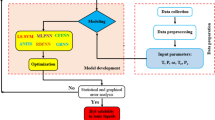Abstract
The efficient precipitation of dissolved silica from Bayer process liquor is essential for the production of high-quality alumina and the reduction of excessive scaling in the heat exchangers in the evaporation building of Bayer processes. The accurate prediction of silica solubility in Bayer liquor is one of the key parameters in improving the design and operation of the desilication process. Previous findings, particularly with respect to the influence of temperature and concentrations of caustic soda and alumina on the solubility of silica, are inconclusive. In this article, experimental results are presented over a wide range of temperature and alumina and caustic soda concentrations. Attempts are made to utilize artificial neural networks for identifying the process variables and modeling. The radial basis function neural network architecture was used successfully to generate a nonlinear correlation for the prediction of the solubility of silica in Bayer process liquor. The resulting correlation can predict the present data and the control data of other investigators with good accuracy.
Similar content being viewed by others

Abbreviations
- B:
-
CB0/CA0
- C:
-
CC0/CA0
- CA0 :
-
Concentration of Na2SiO3 in the liquor (kg/m3)
- CB0 :
-
Concentration of NaAlO2 in the liquor (kg/m3)
- CC0 :
-
Concentration of H2O in the liquor (kg/m3)
- CD0 :
-
Concentration of caustic soda in the liquor (kg/m3)
- CAL :
-
Alumina concentration [kg (Al2O3)/m3]
- Cb :
-
Bulk silica concentration [kg (SiO2)/m3]
- C*:
-
Saturation concentration of silica [kg/m3]
- C*:
-
Output vector
- D:
-
CD0/CA0
- G:
-
Green function
- I:
-
Identity matrix
- kDSP :
-
Reaction constant (m4/kg · min.)
- KD :
-
Equilibrium constant of dissolution reaction
- KP :
-
Equilibrium constant of the precipitation reaction
- m:
-
Constant in Equation 12
- M:
-
Stoichiometric constant
- N:
-
Number of exemplar
- n:
-
DSP deposition rate (kg/m2 · min.)
- t:
-
Center of Gaussian activation function
- T:
-
Temperature (K)
- x:
-
Input vector
- X*:
-
Equilibrium fractional conversion of Na2SiO3
- w:
-
Weight vector
- Φ:
-
Interpolation matrix
- φ(·):
-
Activation function
- λ:
-
Regularization parameter
- σ:
-
Radius of Gaussian activation function
References
P.G. Cousineau and G.D. Fulford, “Aspect of the Desilication of Bayer Liquor,” Light Metals 1987, ed. R. Zabreznik (Warrendale, PA: TMS, 1987), pp. 11–17.
H. Müller-Steinhagen, M. Jamialahmadi, and B. Robson, “Understanding and Mitigating Heat Exchanger Fouling in Bauxite Refineries,” JOM, 46 (11) (1994), pp. 36–41.
G.A. O’Neill, “Prediction of Heat Exchanger Heat Transfer Coefficient Decay Due to Fouling,” Light Metals 1986, ed. R.E. Miller (Warrendale, PA: TMS, 1986), pp. 133–140.
A. Duncan (Paper presented at the 1994 TMS Annual Meeting, San Francisco, CA, February 27–March 3, 1994).
M. Jamialahmadi and H. Müller-Steinhagen, “Thermodynamic Relationships for the Solubility of Silica in Bayer Process Liquor,” Aluminum 68, Jahrgang (1992), pp. 230–233.
T. Oku and K. Yamada, “The Dissolution Rate of Quartz and the Rate of Desilication in Bayer Liquor,” Light Metals 1971, ed. T.G. Edgeworth (Warrendale, PA: TMS, 1971), pp. 31–45.
A.N. Adamson, E.J. Bloore, and A.R. Carr, “Basic Principles of Bayer Process Design,” J. Extr. Met. of Aluminum, 1 (1963), pp. 23–58.
M.G. Leiteizen, “Kinetics of Converting Bauxite Silica to Sodium Aluminosilicate,” TSV Met., 45 (1972), pp. 37–40.
P.J. Cresswell, “Factors Affecting Desilication of Bayer Process Liquors,” CHEMECA, 48 (1984), pp. 285–292.
K.J. Hewett, A.J. White, and G.I. Roach, “Silica Solubility in Plant Liquors,” AJW23/MDR (Confidential Report) (April 1987).
A.M. Shaw, F.J. Doyle, and J.S. Schwaber, “A Dynamic Neural Network Approach to Nonlinear Process Modeling,” Computers Chem. Eng., 21 (1997), pp. 371–385.
L.H. Unger, B.A. Powell, and S.N. Kamens, “Adaptive Neural Nets for Fault Diagnosis and Process Control,” Computers Chem. Eng., 14 (1990), pp. 561–572.
M.J.D. Powell, “Radial Basis Functions for Multivariable Interpolation: A Review,” IMA Conference Proceedings on Algorithms for the Approximation of Functions and Data (Shirvenham, U.K.: RMCS, 1985), pp. 143–167.
M.J.D. Powell, “Radial Basis Function Approximations to Polynomials,” Numerical Analysis 1987 Proceedings (Dundee, U.K.: 1988), pp. 223–241.
T. Poggio and F. Girosi, “Regularization Algorithms for Learning That Are Equivalent to Multilayer Networks,” Science, 247 (1990), pp. 978–982.
D.R. Baughman and Y.A. Liu, Neural Networks in Bioprocessing and Chemical Engineering (New York: Academic Press, 1995).
J.J. Kotte, “Bayer Digestion and Pre-Digestion Desilication Reactor Design,” Light Metals 1989, ed. P.G. Campbell (Warrendale, PA: TMS, 1989), pp. 46–81.
I.Z. Pevzner et al., “Mathematical Description of the Alumina Solution Desiliconizing Process,” TSV Met., 16 (1975), pp. 53–57.
Author information
Authors and Affiliations
Additional information
M. Jamialahmadi earned his Ph.D. in chemical engineering at Aston University in 1983. He is currently a professor and dean of the Petroleum Industry Research Center, Ahwar, Iran.
H. Müller-Steinhagen is currently a professor and head of the School of Engineering in the Environment, University of Surrey.
Rights and permissions
About this article
Cite this article
Müller-Steinhagen, H. Determining silica solubility in bayer process liquor. JOM 50, 44–49 (1998). https://doi.org/10.1007/s11837-998-0286-6
Issue Date:
DOI: https://doi.org/10.1007/s11837-998-0286-6



